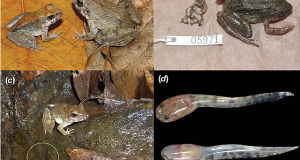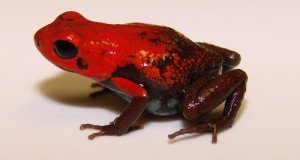While the Emperor Scorpion and the South African Flat Rock Scorpion are, by today’s standards, huge and impressive, they pale in comparison to their extinct relatives. Imagine, if you will, an 8-foot-long scorpion sporting spiked claws that extended 2 feet from its body! Well, thanks to newly uncovered fossil evidence, we need not imagine so hard – such fantastic beasts did indeed exist. Known as Sea Scorpions or Pterygotid Eurypterids, some, such as Acutiramus, were larger than a person!
Natural History
Sea Scorpions are the ancestors of modern-day scorpions, and perhaps of all Arachnids. Pre-dating the dinosaurs, they emerged approximately 470 million years ago, and roamed the seas (and fresh waters) for over 100 million years.
Today’s scorpions are amazingly similar to these prehistoric giants, and, along with Horseshoe Crabs, are among the oldest creatures to inhabit the earth. I have since childhood been awed by exhibits showing re-creations of their habitats (please see photo), and especially by the actual fossil of an ancient Horseshoe Crab on display at the American Museum of Natural History in NYC, which seems indistinguishable from those alive today (please see photo).
Why Were They So Large?
There had long been tantalizing clues that hinted at the Sea Scorpions’ massive size, the most telling being the discovery of a nearly 20-inch-long claw in Prum, Germany. Theories abound as to why they grew so large – perhaps it was a result of an evolutionary “arms race” with other massive invertebrates of the time, such as 5-foot-long millipedes and coffee-table-sized spiders. Other possibilities include the effects of an oxygen-rich atmosphere and the absence of vertebrate competitors.
Well-Armed but “Weak”
The Sea Scorpions’ massive claws are armed with long, sharp spikes, prompting some to refer to them as the “Invertebrate T. rex”. However, a study recently published in the Bulletin of the Buffalo Natural History Society raises the possibility that Sea Scorpions were not the nightmarish predators that many believed them to be. Based on reconstructions, it seems that the power of the claws was limited by mechanical constraints. They would not, for example, have been able to crack the shells of potential prey animals such as Horseshoe Crabs.
Also, the lack of an “elbow joint” between the claw and body limited mobility – unlike modern scorpions, Seas Scorpions could not raise their claws above their bodies. Sea Scorpions likely captured small, bottom-dwelling animals (please see drawing linked below) and were not a major predator of fast-moving fishes. Some have even suggested that they were – horror of all horror for scorpion fans – vegetarians!
Today’s Giants
 Over 2,000 species of scorpions survive today. The largest of these is the South African Rock Scorpion, Hadogenes troglodytes, which reaches 8.5 inches in length; the ever-popular Emperor Scorpion, Pandinus emperor, while not quite as long, is still considered a modern-day giant. The USA’s largest is the 4-inch-long Brown or Florida Bark Scorpion, Centruroides gracilis. A number of scorpions never exceed 0.3 inches or so in length.
Over 2,000 species of scorpions survive today. The largest of these is the South African Rock Scorpion, Hadogenes troglodytes, which reaches 8.5 inches in length; the ever-popular Emperor Scorpion, Pandinus emperor, while not quite as long, is still considered a modern-day giant. The USA’s largest is the 4-inch-long Brown or Florida Bark Scorpion, Centruroides gracilis. A number of scorpions never exceed 0.3 inches or so in length.
Further Reading
Drawings of Ancient Sea Scorpions and their Prey
Scorpions: an Overview of Popular Species
Why Were Prehistoric Insects so Huge?
Giant Sea Scorpion image referenced from wikipedia and originally posted by University of Bristol/Associated Press
National Museum of Natural History, palaeontological exhibition, ordovician, Washington D.C image referenced from wikipedia and originally posted by Fritz Geller-Grimm
 That Reptile Blog – Reptile, Amphibian and Exotic Pet Care and Information
That Reptile Blog – Reptile, Amphibian and Exotic Pet Care and Information



